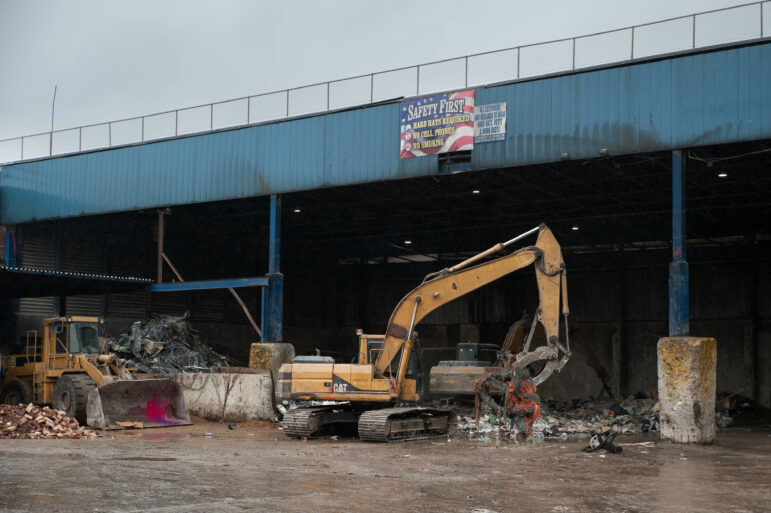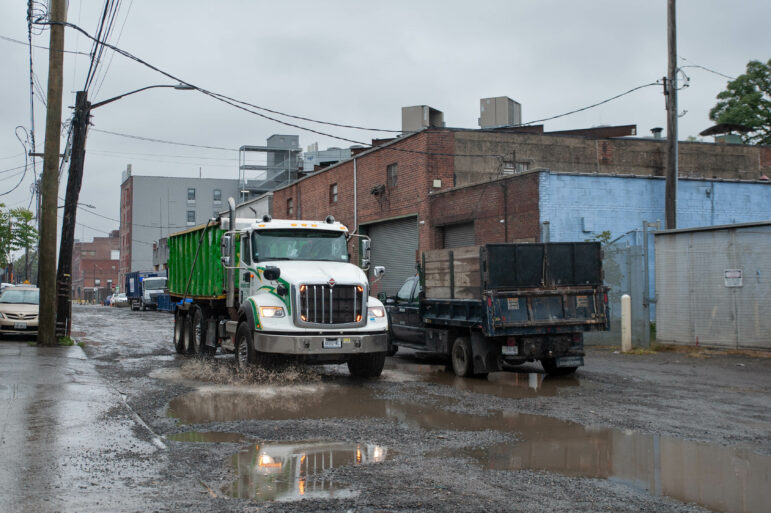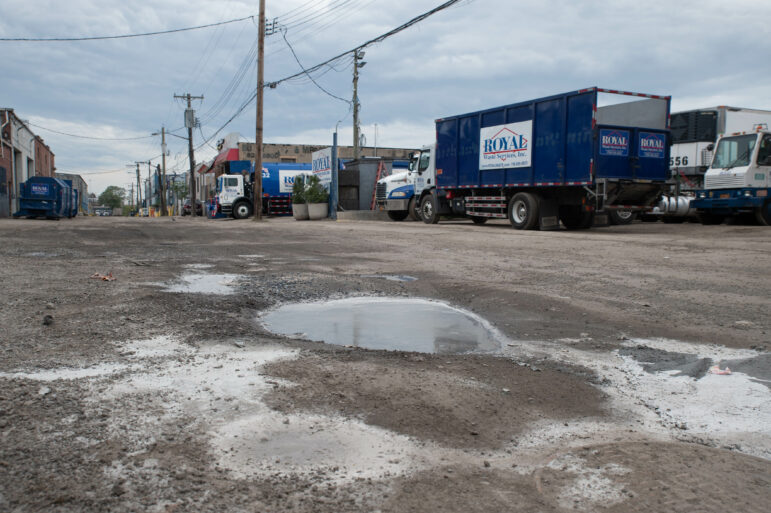For two decades, residents in Jamaica’s Bricktown say they’ve had to contend with the stench and debris from unenclosed waste transfer facilities nearby. A settlement reached with the facilities’ operators last month could change that for the community, one of the three city neighborhoods most burdened by waste infrastructure.

Twenty years ago, Caroll Forbes noticed a foul, rotten odor hanging in the air around her childhood two-story brick home, located on a picturesque residential block in Jamaica, Queens. Concerned that there must be a dead body somewhere in the immediate area, Forbes called 911.
Only after no corpse was found did she learn the unpleasant odor was actually coming from privately-owned local waste transfer stations—American Recycling Management LLC and Regal Recycling Co. Inc.—that had recently arrived on Douglas Avenue, just four blocks away.
Waste transfer stations receive garbage, sort it, and hold it temporarily before reloading it back onto trucks headed for landfills, mainly in Pennsylvania and New York State, according to Department of Environmental Conservation’s 2021 annual reports.
Two decades and many complaints later, the stench is still there. But hopefully not for long.
In September 2021, Forbes described these experiences as a plaintiff in a lawsuit brought by residents and environmental groups Raritan Baykeeper and Riverkeeper against the transfer station owners, and last month, they reached a settlement.
The settlement aims to improve the quality of life for residents and lead to changes at the facilities to contain odor, noise, and dust, and manage stormwater to comply with Clean Water Act. The suit alleged that unpermitted stormwater from the facilities, including water that had mixed with garbage, was entering nearby Jamaica Bay via a municipal storm sewer.

When the lawsuit was filed in 2021, New York Lawyers for the Public Interest (NYLPI), a civil rights law firm representing the plaintiffs, found the facilities had discharged stormwater into the Bay without a general permit on 409 days for the five previous years, using rain data from the National Oceanic and Atmospheric Administration.
“They [the facilities] weren’t even doing the bare minimum,” said Sonya Chung, a staff attorney in the environmental justice program at NYLPI.
Since the end of June 2022, the waste companies have obtained all necessary permits to comply with the Clean Water Act, according to the EPA’s Enforcement and Compliance History Online (ECHO) website. In court papers, the waste companies denied the allegations made against them in the lawsuit, but agreed to the settlement because it “is in their mutual interest to resolve this matter,” records show.
“I’m very happy because I was thinking about moving out,” Forbes said in an interview after the settlement was reached.
Life in “Bricktown”
The situation has dragged on for two decades, but locals say that up until now, little has been done to help the predominantly Black and brown neighborhood of Bricktown, made up of modest multi-family and single-family homes.
The Southeast Queens community is one of the three in New York City most burdened by waste infrastructure. Together, waste transfer stations in the South Bronx, North Brooklyn, and Southeast Queens manage 76 percent of the city’s waste disposal, according to a New York City Council Fair Share report from 2017.
Across the street from Forbes’ house, little league football players race across a sprawling green field at Detective Keith Williams Park. Joggers make their way around the track, and tennis players volley back and forth at one of the eight newly renovated tennis courts. The residential community is separated from the industrial activity only by a wall on the north side of Liberty Avenue, a busy commercial street right next to the park. And behind that wall is Regal’s dump, filled with piles of waste.
“About three years ago, I had a student who felt so bad after two times [playing in the park] that she then didn’t come back,” tennis coach Billy Meeks said about the stench wafting through the neighborhood green space.
Forbes said she hasn’t been able to exercise outside every time she wanted due to the odor, and has had to clean her home frequently and use essential oils and a diffuser to mask the smell. “You know, going an extra mile just for comfort.”
But odor is perhaps the least of the issues caused by the dumps.
The CDC lists air pollution coming from sources like dumps as one of the common asthma triggers. Hundreds of trucks per day loaded with garbage rumble through the local streets, spewing fumes and noise, which increases the risk of childhood asthma even more, according to a 2005 study from New York’s Department of Health.
Children in Jamaica, Queens, have the highest rate of asthma-related trips to the hospital than any other Queens neighborhood, according to NYC Department of Health data from 2016. And it affected Forbes' family too.
Forbes alleges that since living with her, several of her grandchildren developed asthma from dust created by waste processing at the transfer stations, leading to severe asthma attacks, including ambulance trips to the hospital. When a seventh grandson came to visit her from out of town, she describes in the lawsuit, his asthma acted up, becoming more severe than when he was home.
Parallel to Liberty Avenue is Douglas Avenue, the site of the waste facilities. It’s an unpaved gravel road covered in grime on hot, dry days and swamped in brown, murky pools on rainy days. The cacophony of truck engines, honking, and beeping is a reality Monday through Saturday, increasing the traffic in the area, contributing to excessive noise and engine pollution above the New York City average, based on the Department of Health’s (DOH) Environment and Health Data portal.

Nikol Mudrová
A truck on Douglas Avenue.
The trucks carry construction, residential, and commercial waste from all over the city––over 600 tons of garbage on a daily average at American Recycling Management and over 430 tons at Regal Recycling, according to the Department of Environmental Conservation’s 2021 annual reports.
“You feel like vomiting,” said another local resident, Compton Meerabux, of living nearby, adding that it makes him feel like he can almost “taste the smell of the garbage,” especially when it rains, or when a truck drives past.
What happens now?
After four months of investigation and interviewing 17 nearby residents, elected representatives, health officials, lawyers, and environmental experts, City Limits’ heard a number of sources call for one desired solution to deal with the Queens dumps: enclosing them.
“That’s all we’ve been asking for, actually,” said Oster Bryan, president of the St. Albans Civic Improvement Association, in an interview in the fall, while the settlement was still being negotiated.
His association was involved in putting together The State of Waste in Queens report last year, which explicitly grapples with the garbage issues on Douglas Avenue. According to the report, District 12 in Queens (Jamaica) remains the only community district with unenclosed construction, demolition, and scrap metal transfer stations in an M1 “heavy industrial” zone in the city.
Enclosing the facilities was the most optimal outcome of settlement negotiations, said Chung. “The more you enclose the facility, the better it's going to be for the people who live right outside of it,” she said.
However, because of “economics,” according to Chung, Regal’s settlement agreement does not include full enclosure of their facility. Instead, over the next three years, Regal will install clear plastic sheeting to limit dust in their construction and demolition waste building, along with other operational improvements.
Chung attributed Regal’s decision to not fully enclose their facility to “economics.” Regal Recycling did not respond to multiple requests for comment.

Nikol Mudrová
Puddles and mud along Douglas Avenue, where the waste stations are located.
On the other hand, American agreed to fully enclose their facility in the settlement, something they’ve been considering for four years, said Dominic Susino, the company’s chief financial officer. Now that the settlement has been reached, the company is working with engineers to see if it's possible to get the entire facility under a single roof.
“That way, once the door shuts behind [a truck], everything happens within the building,” Susino said.
American Recycling, he said, also plans to connect its dump to the nearby rail service, replacing trucks exporting waste to landfills with trains to decrease street traffic, according to Susino. That would likely earn the company exemptions to the city’s 2018 Waste Equity Law, which reduced the amount of waste transfer facilities are legally allowed to process unless they commit to exporting their debris by rail instead of trucks.
American is now waiting for approval from the city’s Department of Buildings. Once they get a green light, it will take four years to fully enclose the facility and convert its waste to rail, according to the settlement.
In the meantime, stench and dust are still spreading beyond the dumps.
In 2020 and 2021, DEC inspectors who visited the Douglas Avenue sites concluded that “no offsite odors were detected,” according to inspection reports obtained and reviewed by City Limits. Rebecca Bratspies, who has been researching the facilities as part of her work at CUNY School of Law, where she runs the Center for Urban Environmental reform, found that hard to believe.
“Quite frankly, I don’t know how any inspector could visit these facilities and say that there was no odor off the property,” she said, adding that every time she visited Douglas Avenue herself, the stench had been overwhelming.
It’s essentially at the discretion of inspectors, she said, to determine whether a facility violates its permit. In her opinion, inspectors have a different sense of what constitutes a nuisance than the people who live in Bricktown, and also what is deemed acceptable in a community of color—compared to, for example, dumps like the 91st Street Marine Transfer Station in the Upper East Side, which the city opened in an effort to more equitably cite its waste management facilities and which was met by intense local opposition.
“It depends on whether an inspector says that the odor is too bad or is good enough,” Bratspies said. DEC did not respond to questions regarding the 2020-2021 inspections.
Confusion about which city or state agency has jurisdiction over enforcement has also been a challenge for Bricktown residents. City Limits reviewed emails from former District 12 Chairwoman Rene Hill that she sent in July 2020 to DOB, DEC, and the city’s Department of Environmental Protection (DEP) asking someone to address neighbors’ odor complaints.

“We need to do something about this. If your agencies are not responsible for the compliance, what agency is?” Hill wrote in the email. “These facilities must comply with the law. It is unfair that our residents continue to be ignored.”
According to the DOB, DEP handles odor complaints. But the DEP's press office said the agency only responds to 311 calls, and that there have been no odor complaints within the last 14 months. New York State Senator Leroy Comrie, who represents Jamaica, and Queens Borough President Donovan Richards did not respond to a request for comment about what they are doing to address the ongoing issue.
Councilmember Nantasha Williams, who represents Jamaica, said she tries to work with the facilities to directly address residents’ complaints. “There's been some traction and conversations around renovating the facilities, so they aren't producing the environmental hazards that they're currently producing,” she said in an interview in the fall.
Better communication between residents and the waste transfer stations is even included in the lawsuit’s settlement. American and Regal will meet with the plaintiffs and community representatives over the course of their settlement terms to discuss community concerns, updates to the facility, and improve their relationship with one another.
This was especially important during the negotiations for Bricktown residents, who’d long felt disregarded by both the waste companies and the government agencies in charge of oversight. “These suits have preventative effects to let industries know that organizations and communities are keeping them accountable,” Chung said.
Residents are still waiting to see if real change will happen.
“It would be nice to actually walk down the street without dust and dirt and mud continuously being there,” Forbes said. “It would be wonderful to see the area clean and dust free.”


Leave a Reply